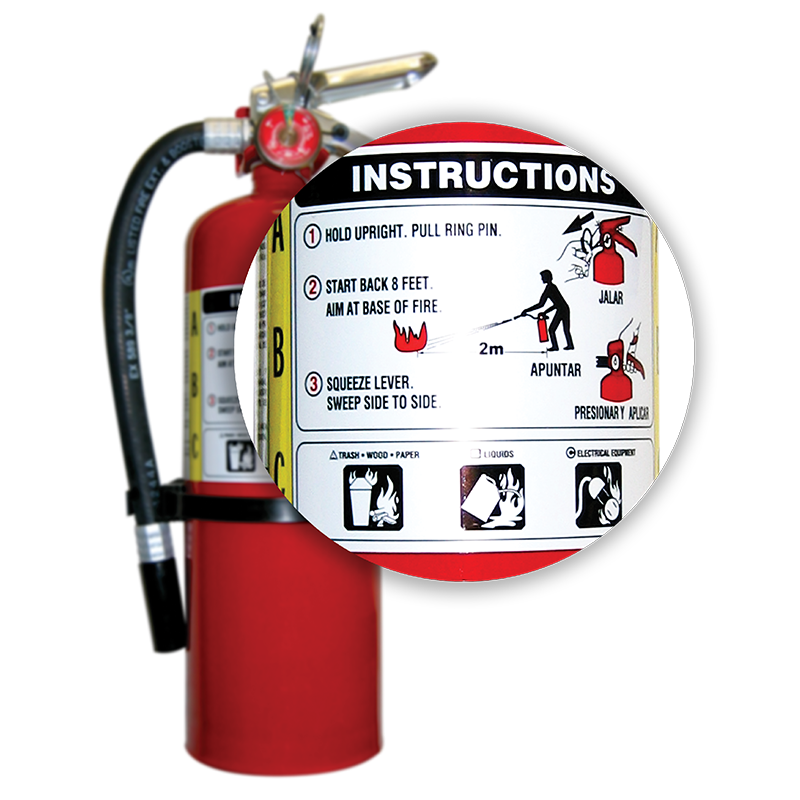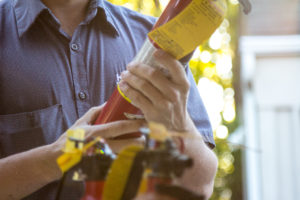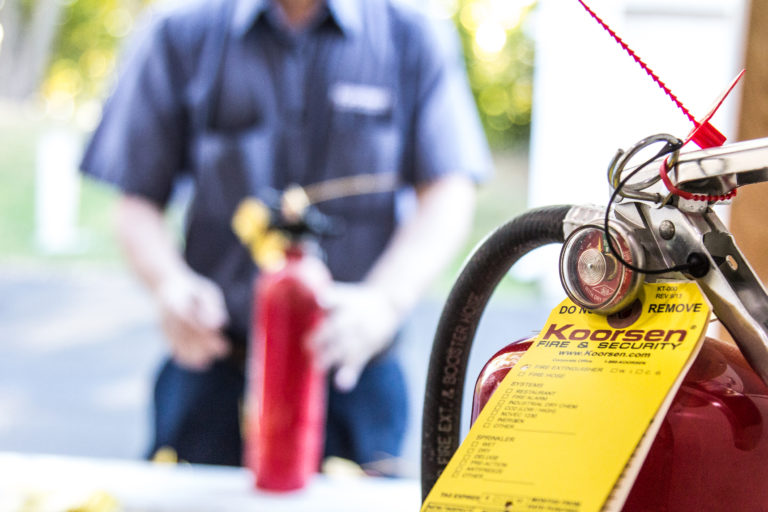SALES & INSTALLATION
Whether you need a Class K extinguisher in your kitchen or you need to outfit an entire building with fire extinguishers, our fire extinguisher experts can help you out. Our fire protection specialists will review your facility to match your fire extinguishers’ type, size, and placement to your needs and national fire protection standards.
We offer all kinds of portable fire extinguishers from quality manufacturers such as Amerex, Ansul, Badger, and Buckeye. However, placing fire extinguishers is only the start. We also provide continued inspections and maintenance to ensure the safety of your people and property.


INSPECTION & MAINTENANCE
Just having a fire extinguisher isn’t enough to ensure the safety of your people and property. An astounding 30% of portable fire extinguishers in the workplace are not in good working order. And just because yours has an updated inspection tag doesn’t mean it’s ready for an emergency. Make sure that you’re ready by working with a company you can trust. We don’t take shortcuts, and we don’t take chances with your safety.
SERVICE & TRAINING
Fire Extinguisher FAQs
Typically, you must be able to see the fire extinguisher from all viewable angles. Otherwise, a sign may be required. For further clarification, it is best to contact a Koorsen associate or your local AHJ.
It depends on your business classification and hazard type. Typically, you will find 10-pound ABC fire extinguishers in standard office buildings and class K fire extinguishers in commercial kitchens.
Fire extinguishers should be checked monthly by the business owner or designated employee and inspected annually by a certified Koorsen fire extinguisher tech.
A site survey is needed to determine the exact number. It depends on the hazards present in the occupancy and how that occupancy is classified. Depending on this occupancy classification – the travel distance and size of the units will vary.
Types of Fires
Fire fueled by flammable liquids unique to cooking, such as cooking oils and greases.
Fire from combustible metals, such as aluminum, titanium, magnesium, lithium, zirconium, sodium, and potassium.
Fire in which an energized electrical element is the cause of the fire.
Fire in which flammable liquids and/or gases become involved.
Fire with ordinary combustible materials, such as wood, paper, rubber, cloths, and plastics.
FIRE EXTINGUISHER TYPES
Multipurpose Dry Chemical ABC:
The most common fire extinguisher is listed for Class A, B, and C fires and can be found in offices, schools, hotels, etc.
Carbon Dioxide:
Doesn’t leave a residue and is listed for Class B and Class C fires in food prep areas, labs, and printing areas.
Halotron/Clean Agent:
Leaves no residue and is non-conductive and non-corrosive. Listed for fires in electronic equipment.
K-Class:
Wet chemical that forms a foam blanket to prevent reigniting of kitchen fires.
Water Mist:
Uses distilled water where contaminants can cause damage like MRI equipment and museums.
Purple K:
Dry chemical listed for Class B flammable liquids and pressurized gases at oil, gas, and chemical facilities.
Film-Forming Foam:
FFFP (film-forming fluoro protein) and AFFF (aqueous film-forming foam) are rated for Class B and Class A fires.
Cartridge Operated:
The cylinder is non-pressurized with a separate cartridge on the side. Ideal for harsh environments.
Class D Model:
Dry powder extinguisher listed for combustible metals.
COMMON FIRE EXTINGUISHER INSPECTIONS & MAINTENANCE
Placing fire extinguishers is only the start. Check out our maintenance and inspection tips and tricks below for more details on how to keep your building up to code.

EXTINGUISHER MONTHLY INSPECTION
Businesses are required by OSHA to ensure monthly fire extinguisher inspections are performed on all portable fire extinguishers in the business facility. Businesses can perform monthly inspections without the need for a professional. Any employee can perform monthly inspections. However, it’s important to ensure that the designated employee knows what to look for and how to record the inspection correctly. Below is what to look for and do during a monthly inspection. For more details and help, contact your local Koorsen Fire & Security branch.
- Are fire extinguishers in their proper locations? Extinguishers should be on a specially designed bracket on the wall or in a marked box or glass extinguisher cabinet.
- Are units in clear view and accessible? Extinguishers should be visible and clear of any obstructions like boxes, cubicle walls, or furniture.
- Is the pressure indicator needle in the green? If the pressure indicator shows that the cylinder is under or overcharged, you will need to contact Koorsen to get it either recharged or replaced.
- Have the monthly inspections tags been signed? Once the inspection has been completed, you will need to sign off on the monthly inspection tag. You should also include the inspection details in a separate report containing all the monthly extinguisher inspection details. You should also check the annual inspection tag to ensure a professional inspection has been performed within the past year. Contact Koorsen if you find an extinguisher with an expired annual inspection tag.
- We offer all the high-quality products you could want, configured and maintained for your needs by experienced associates to bring you total protection from one source.
ANNUAL MAINTENANCE
- Visually inspect extinguisher.
- Check the test and maintenance dates.
- Weigh extinguisher. (CO2)
- Visually inspect pressure indicator. (when applicable)
- Remove safety pull pin.
- Install new tamper seal. (Some units may require additional inspection procedures.)
- Remove discharge hose and inspect valve assembly.
- Check CO2 for continuity. (when applicable)
- Clean extinguisher.
- Attach a new certification tag.
- Complete Fire and Safety Report.
- Ensure customer understands completed work.
additional Maintenance
Maintenance Schedule
- 5-year hydrostatic test on carbon dioxide and water-based extinguishers.
- 6-year maintenance on stored-pressure extinguishers.
- 12-year hydrostatic test on stored pressure and cartridge-operated extinguishers

